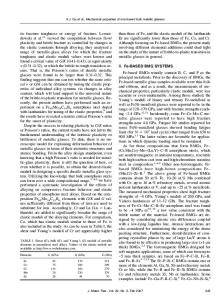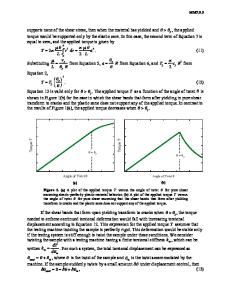Size matters in mechanical behavior of bulk metallic glasses
- PDF / 346,798 Bytes
- 2 Pages / 585 x 783 pts Page_size
- 49 Downloads / 327 Views
I
t has not been possible thus far to use diffraction methods, such as x-ray diffraction, to localize the precise locations of hydrogen atoms in nano-sized crystals due to their strong atomic vibrations and small scattering cross sections. An international team of researchers from the Institute of Physics of The Czech Academy of Sciences, Laboratoire de Cristallographie et Sciences des Matériaux (CRISMAT), and Laboratoire Catalyse et Spectrochimie has now developed a method to locate hydrogen atoms within submicrometer crystals. As reported in a recent issue of Science (doi:10.1126/ science.aak9652), this was achieved using the recently developed method of dynamical refinement of precession electron diffraction tomography data. “We followed standard crystallographic routine to collect a complete diffraction data set, then localized the heavy atoms (i.e., all non-hydrogen atoms) by ab initio methods and further refined using our dynamical refinement method,” says Lukáš Palatinus from The Czech Academy of Sciences and lead author. “The key ingredient in this procedure is the dynamical refinement method, which enables us to calculate the diffracted intensities and the difference potential map. This allows the localization of hydrogen atoms, which are
Size matters in mechanical behavior of bulk metallic glasses
M
etallic glasses are amorphous materials produced by rapidly quenching metallic alloys, “locking” them into a glassy state rather than the crystalline structures into which metals typically form. The unusual atomic structure of bulk metallic glasses (BMGs) affords
Projection of cobalt aluminophosphate crystal structure with superimposed difference potential map. Hydrogen positions are located by finding the local maxima of this potential map. Credit: Science.
found at the maxima in the difference potential map,” adds co-author Philippe Boullay of CRISMAT. “The dynamical refinement method developed by Palatinus et al. features an impressive enhancement in accurate determination of crystal structure by electron diffraction technique, with reduced discrepancies in atomic positions and more meaningful reliability factor,” says Doug Perovic, an expert in scanning transmission electron microscopy and spectroscopy of nanomaterials structure and chemistry at the University of
Toronto, who was not involved in this study. “The ability to localize the lightest atom-hydrogen is a clear demonstration of the capability of this method,” he adds. “We hope our work can attract newcomers in the field to develop, extend, and democratize the use of electron crystallography,” Boullay says. In the future, the researchers plan to take their refinement method to the next stage by analyzing and improving remaining imperfections, and extending the scope of analysis to twinned crystals, for example. Xiwen Gong
ultrahigh yield and tensile strengths, low stiffness, and often a remarkable fracture resistance putting BMGs among the most damage-tolerant materials known. These desirable qualities make metallic glasses an interesting en
Data Loading...











